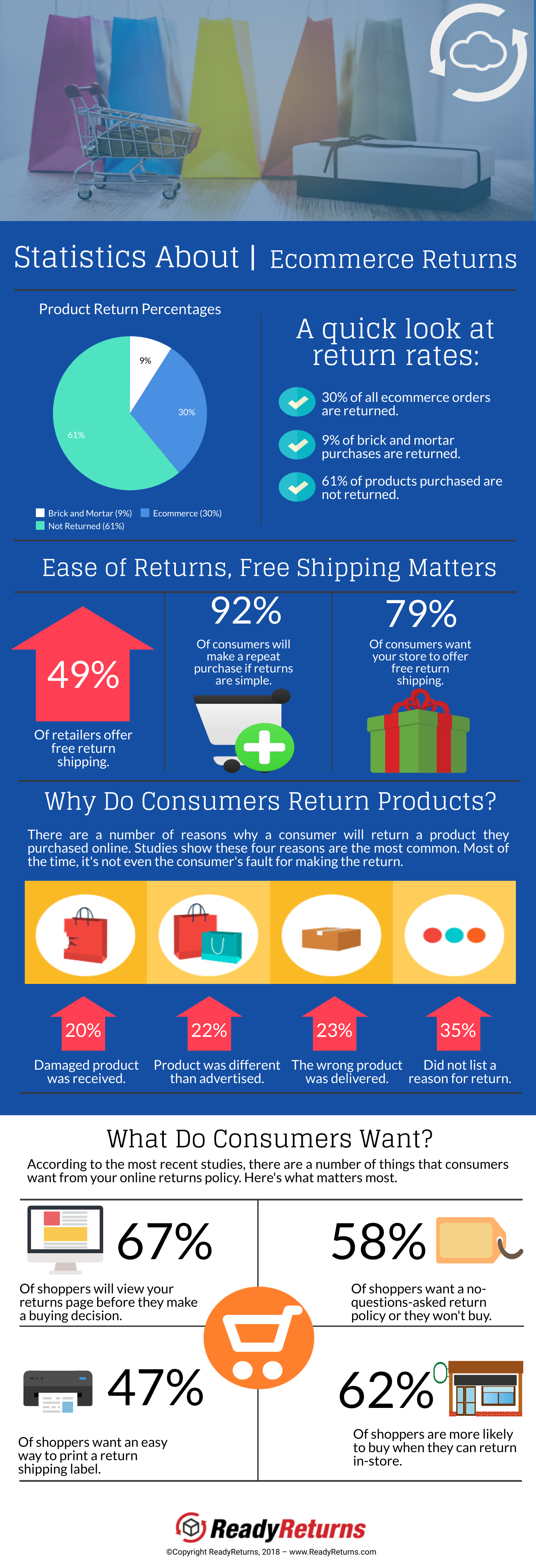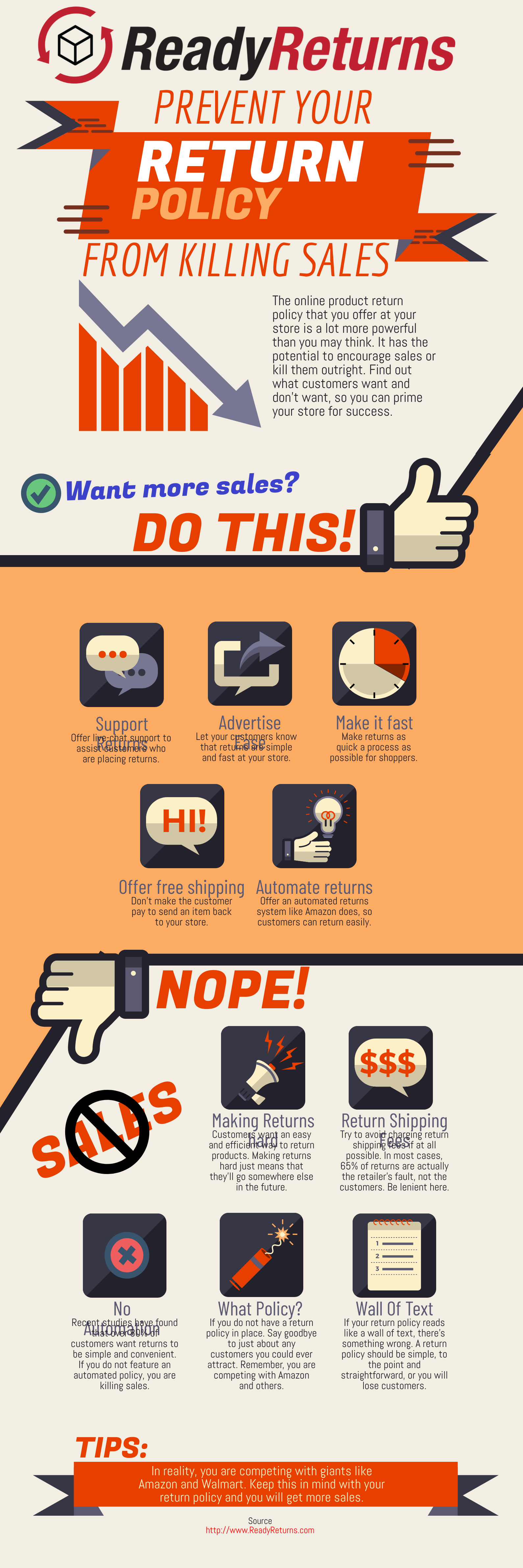E-Tailers: Follow These Best Practices for Ecommerce Returns to Win Customers Over for Life

To put it another way, repeat customers are essential to your business.
There are, however, risks associated with returns. According to the National Retail Federation (NRF) 10.6% of online purchases were returned in 2020. For National Returns Day 2020 (January 2nd), more than 1.5 million packages were returned – further highlight the propensity of returns during the busiest part of the ecommerce year: when the holidays wind down. Most of the time, returns cost you money since you’ve shipped to and from the customer, plus you can’t always resell the returned merchandise, so your bottom line suffers.
The good news is that there are ways to balance customer satisfaction and offer hassle-free returns at your online store. A great returns experience can increase sales in the long run as your best customers often make the most returns, as noted in the NRF report.
Read on to learn more.
“A great e-commerce experience requires more than competitive prices, a robust selection of goods, fast shipping and easy returns … it takes them all. Today’s consumer mindset has changed. Services like Amazon Prime have set the bar at a higher level, with speedy delivery, low prices, a vast selection and hassle-free returns.”
Returns in Ecommerce by the Numbers
The most recent statistics on ecommerce returns are eye-opening. You will have a different return rate depending on the product you sell and the type of customer you serve. Your ecommerce returns will be lower if most of your customers are repeat customers who know your merchandise.
You may see a 50% increase in ecommerce returns after the holidays than expected. For clarity, the National Retail Federation estimated $101 billion in holiday returns alone in 2020. Returning gifts during the holiday season can cause ecommerce retailers much grief. The most regularly returned items are clothing and shoes because customers often purchase multiple sizes to return items that do not fit.
To better help you understand how the numbers stack up, take a look at this infographic we created on ecommerce return statistics:

The Return Rate for Ecommerce on Average
According to a recent study conducted in the U.K., ecommerce returns for women’s clothing averaged 23%. However, returns for beauty products averaged 4%, with an industry average of 15%. Although ecommerce return rates in some categories or brands may be higher, because a smaller share of consumers is returning their purchases than was the case just a few years ago.
This downward trend may be attributable to consumers becoming more knowledgeable about online shopping and ecommerce websites using technologies such as virtual reality to help customers research products before purchasing.
Needless to say, refunding 15% of the orders you ship and paying for return shipping can be painful. Nevertheless, you must continue to provide this service to your customers. ecommerce returns should be considered a crucial element of your customer retention strategy.
Easy Ecommerce Returns Drive Repeat Sales
While online reviews are an essential method of gaining consumer trust, any online purchase still poses risks to consumers. An ecommerce consumer survey from 2019 found that half of the consumers define a positive shopping experience as easy returns. When it comes to international ecommerce, return policies are even more crucial. Making returns simple will encourage most customers to make repeat purchases.
Research indicates that online shoppers gravitate towards shops with transparent policies when shopping online. UPS surveyed Americans and found that 44% returned an item they purchased online.
Whether a consumer purchases again from a retailer is directly affected by their experience with those returns. Heretofore, your customer’s experience with returns could influence their likelihood to repeat business almost as much as the initial sales process.
What is the Average Cost of Ecommerce Returns?
According to Shopify, online retailers are predicted to lose $428 billion due to ecommerce returns. To better understand what that means, multiply 15% to 20% ecommerce return rates by your expected sales volumes in the coming year if you want to understand what it means to your bottom line. Be sure to account for restocking, shipping costs (if you pay for them), and any lost or damaged merchandise.
Determine the average return rate of your own ecommerce business using the data you have on your past ecommerce returns. If you are below 15%, you’re doing much better than most. Depending on your ecommerce return rate, you may need to increase your return strategy (It is simply a cost of doing business to have a higher ecommerce return rate unless you sell large items such as apparel).
You should include the ecommerce return rate in your Key Performance Indicators (KPIs) if you do not already measure it. It can be helpful to understand how ecommerce returns affect your profit margin to manage your business better.
By the way, if you’re currently selling on Shopify, make sure you read our related guide: How to Streamline Shopify Returns.
Free Returns: The Hidden Cost
When it comes to ecommerce returns, free shipping is almost as appealing as when it comes to free shipping when making an order, and is crucial part of the process of offering hassle-free returns to your customers.
However, free returns can work against you by encouraging consumers to buy more items in anticipation of returning some. That may not be a bad thing, mainly if you sell apparel, since consumers may be more confident to make a purchase when they can try clothes on at home.
Approximately 38% of online shoppers ordered extra items that they intended to return last year. Many online shoppers won’t purchase an item if the return shipping isn’t free, but this consumer desire comes at a cost. This is because online shops are often forced to increase prices to compensate for the return shipping costs.
Pro tip: Should you include the cost of returns in your pricing? By regularly reexamining your ecommerce returns rate, you can adjust your pricing accordingly and actually turn returns into profits over time.
Returns Can Make or Break Your Store
Make sure to factor in lost revenue when you do not offer free return shipping and a liberal refund policy when calculating the costs. If you offer a bad experience with ecommerce returns, your customers may not come back to your online store again in the future. Millennials, in particular, are notorious for shunning your site if you try to contact them about returns.
Additionally, making ecommerce returns simple will allow you to increase loyalty and customer retention. Returning customers are likely to become repeat customers, and most customers who say they would use a store again said it was because they had a good experience with an ecommerce return.
The service recovery paradox proves that customers like your company more if it correctly recovers from mistakes like a damaged package. You can take advantage of this by offering a generous return policy for ecommerce purchases to avoid killing sales with a bad return policy.
Returns & Refunds: Best Practices for Ecommerce
An excellent return policy for ecommerce isn’t complicated. To avoid offering a bad return policy, you’ll want to know a few things in advance. You can decrease your ecommerce return rate and increase customer loyalty by following these best practices:

The Return Policy for Should be Easily Accessible
There should be no ambiguity in your return policy, and it should be easily readable. The key to making your ecommerce return policy easy to find on your site’s desktop and mobile versions is to include prominent links that make it easy to find on FAQ pages or clear web pages.
A return policy that is spelled out and easy to find makes customers feel more confident about returning their products, and studies prove that lenient return policies increase sales. You will also be saving time and money by setting clear expectations about returns before purchase.
Clarify Deadlines for Your Return Policy
Many of your customers weren’t prepared for the possibility of having to return merchandise, even though your ecommerce return policy was a significant factor in their purchasing decisions. Don’t use dense, legalistic language in your return policy, and avoid giving customers a short deadline to return their goods.
Make sure to clearly state your return deadline on your returns page in more than one place; don’t hide it in the fine print. Customers can better understand what’s required of them when returning an item when a clear return policy specifies the time frame for returns.
You are less likely to be blamed if their return deadline is known in advance. Furthermore, a clear return deadline will also allow you to predict revenue since you can book profits for old sales that are older than the return deadline without worrying about refunds. When an item is returned to you, you are more likely to resell it.
Allow In-Store & Shipped Returns
When you allow buyers to make returns at your physical location, you’ll boost customer satisfaction if you have both an ecommerce and a brick-and-mortar store. It would help if you offered in-store returns to your customers since many prefer to do so.
A return in-store provides an upsell opportunity as well. In more than two-thirds of cases, returning customers purchase something else. You might even persuade the customer to buy that other product after returning the first one.
Make it Easy to Generate Labels
When you have a return portal that makes it easy for your customers to return items, you save time. With product returns doubling in the past three years alone, consumers are focused on a streamlined and easy process for returning a product.
Allow customers to see and return items from their last order. Printing a return label should take just a click from there. Your customers can return their items faster and easier by simplifying the return process. You increase the chances of a returned item being in suitable condition for resale by enabling your customers to return a product quickly and easily.
You may also be protected from return fraud by using an online returns portal. Customers can misuse returns by claiming that all the products are in the return box when they aren’t. Other customers may be confused. In order to solve these problems, all the returned items are on a return list.
Print the return list and ask your customer to include it with their return. With this pick list, your customers will be honest, and your warehouse staff will be able to determine if the return is acceptable.
See What Other Retailers Are Doing
It is possible to figure out the best return policy for your business through trial and error. Make use of the expertise of other ecommerce retailers instead. They’ve already done the legwork for you in finding out what consumers want from ecommerce returns.
As you implement your ecommerce returns policy, you may have to tweak it, but building on the experience of others will give you a head start. Take ideas from successful online retailers’ return policies to create your return guidelines.
Describe Your Returns Process
It is overwhelming to consume so much content in our hyper-connected world. If your ecommerce return policy is written in fine print, customers’ eyes will glaze over. It goes against the transparency that’s necessary for a successful return policy.
Instead, you should use graphics, icons, and images to aid your customers in understanding your return policy. A well-designed return policy page also allows you to connect with your customer. Using graphics in an otherwise dry topic can even add a little humor. With the right elements in place, your return policy will resonate and help you keep more customers in the long term.
Turn Returns into Future Sales
Your customers should never see how frustrating and demoralizing returns can be for you. Your empathy could turn the anger of a customer into gratitude. Your customers should be thanked for their efforts in returning items.
A positive attitude and excellent customer service are crucial to turning returns into future sales, according to recent facts about ecommerce returns. So, keep this in mind when creating and administering your return policy.
Understand the Laws Governing Returns
It’s not just good business practice to offer a return policy – it’s the law. Under U.S. federal law, you must accept defective goods back. Also, customers can change their minds within three days of purchasing $25 or more items.
State laws may also govern your return policy. Avoid embarrassment and an appearance of being shady by staying updated on ecommerce return laws.
Maintain a Healthy Profit Margin
If you accept returns on sale items, your profit can be erased, so think about excluding discounted products from your return policy. You should ensure that your retail pricing includes enough margins to cover your operating costs, including returns.
Re-engage with Customers
You should not consider it returns the end of your relationship with a customer. That customer was interested enough to order from you; there’s a good chance they’ll come back.
Keep your relationship with your customers alive after a return. If you handle the return well, it is possible to turn this person into a loyal and profitable customer.
Keep Your Return Policy Up-to-Date
Changes in online retail affect your return policy as well. Your return policies may need to be modified to stay relevant to your customers and business if you track your returns.
You should adjust your strategy if your returns spike. Current statistics on ecommerce returns find that an up-to-date policy is something customers want and also is something that can help you better preserve your customer service model.
5 Ways to Win with Your Return Policy
Be transparent: Multiple pages should contain links to your returns policy. Post your customer service contact information at the top and bottom of your page. Provide your customers with tracking capabilities with returns and refunds, and send a confirmation email. Being transparent with your customers will earn you a great deal of goodwill.
- Include the refund form in your policy. Clearly define what type of refund you will offer, such as credit card refunds, exchanges, or store credit.
- Set a refund time limit. Most of the time, 30 to 90 days is ample time for customers to return a purchase. Setting a time limit on your returns will make your inventory management more effortless.
- Keep it positive. Return policies are essential, but they don’t have to be harsh or punitive. Communicate the information your customers need in a friendly manner without being harsh or punishing.
- Be flexible. Give your customer service reps a reasonable time limit on returns – but don’t be too rigid. The customer can return an item on day 32 of a 30-day return policy. Consider it an honorable request.
COVID-19 Reverse Logistics
We cannot discuss returns without addressing the delays due to the COVID pandemic and its effect on returns and ecommerce. A reverse logistics team’s job is to efficiently handle returns, which is the back end of your supply chain. Your ecommerce business should be prepared to adjust quickly when the unexpected happens.
Despite a rapid growth in ecommerce, supply chain problems persist. It’s crucial to have a robust reverse logistics operation that adapts to changing circumstances to avoid business disruption.
As part of your retail returns policy, transparency and communication should be part of the solution to ecommerce return delays. You can reduce customer anxiety and increase their patience by telling them the reason for the extended return period.
Making a Winning Return Policy
An excellent reverse logistics process is essential when you draft or revamp your ecommerce return policy. Customers will remain loyal to you and grow your business if you provide the service and convenience they expect.
In order to convince and convert with your return policy you need to follow some simple steps.
- Make returns easy and hassle free
- Offer free return shipping
- Allow customers to process returns from mobile devices
- Make it easy to print/generate a return shipping label
- Streamline every step in the returns to make it simple
- Be lenient with your policy: allow at least 30 days for returns
- Offer in-store credit on returns to earn second-chance sales
- Offer to have their return picked up from their residence or office
- Communicate with customers throughout the process and offer comeback deals
- Understand that 40% of products get returned, and happy customers make repeat purchases from stores that make returns hassle-free
Need Even More Tips?
We leave you with this infographic we’ve created that can help you better tailor your return policy to the consumer mindset. If you need any additional tips, we’ve got you covered. Read: The Ultimate Guide to Ecommerce Returns.

What You Should Do Now
Here are 3 ways ReadyReturns can help you deliver amazing return experiences that eliminate prepaid labels and boxes, delight customers, and protect your margins:
Schedule a Demo – See how ReadyReturns turns product returns into your competitive advantage with “Amazon-like” returns and cost-saving features.
Start Your Free Trial of ReadyReturns (No CC Required) – Set up in minutes. Instantly offer QR code returns, product exchanges, and custom return rules that turn frustrated customers into repeat buyers.
Try ReadyCloud at No Cost – Why manage shipping and returns separately? Get ReadyShipper X, ReadyReturns, and more in one unified platform for seamless fulfillment and order management.
Share On:









